|
XII.
|

|
In the Salon of 1884 appeared a painting by a well-known and popular artist entitled "An Affair of Honor."
It represented a duel with rapiers between two women. The scene was laid in a well-known spot in the
Bois de Boulogne where there have been countless encounters of this character. The combatants, their
seconds and friends were all women of the class which inhabits that half-world for which Alexandre Dumas
the younger invented the name. Each personage was a striking portrait of some prosperous courtesan, and
the women, stripped naked to the waist, were both living adventurers of notorious recklessness. The
popularity of the picture was enormous. It travelled all over the world, and was so great that the
artist followed it with a companion and sequel - "The Reconciliation." Here one of the cocottes has
fallen wounded, and her late antagonist forgets her anger and kneels sympathizingly beside her,
while one of the seconds calls up the coach, which at a distance has awaited the outcome
of the fight. The painter of this picture, Emile Bayard, was born at Ferte-sous-Jouarre, in the
Department of Seine-et-Marne, in 1837. In 1853 he entered the studio of Cogniet. He was poor, and
supported himself by designing illustrations for books and newspapers. His first exhibits at the
Salon were of drawings. He served as a volunteer during the Franco-Prussian war, and in 1870 exhibited
a superb drawing representing the battle of Sedan. This drawing made his reputation. It was purchased
by the State, and won for him the decoration of the Legion of Honor.
|
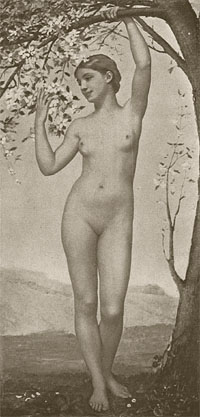
|
Philippe Parrot is an esteemed painter in France, where he is principally employed by decorative and
idyllic subjects. He was born at the village of Excideuil, in the Dordogne, and his early life was a
long struggle with poverty. He contrived to support himself while studying at the Ecole des Beaux Arts
by painting on tea-caddies and cheap fancy boxes for the holiday season, until in 1868 he won at medal
at the Salon, when his prospects improved. He was again medalled in 1870 and 1872, and in 1878 won another
badge of distinction at the Exposition Universelle. His "Spring" is an excellent example of his sound and
conscientious art.
|
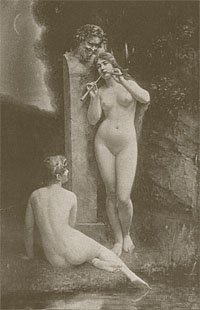
|
Georg Papperitz is one of the modern German artists who have been largely influenced by the French school.
He studied originally at Munich, where he indeed still has his studio and home, but worked also in Paris,
and is a regular exhibitor at the French exhibitions. His style is broad, his color rich and harmonious,
and he is especially happy in such subjects as "An Idyll," two wood-nymphs, one of whom pipes a melody
of evening tribute to a bust of the god Pan, while the landscape darkens in the fading day and a new
moon makes a pale crescent in the sky.
|

|
Jean Jacques Henner has been called the Titian of modern art, and in the sense
of a grand devotion to color and a wonderful power in the painting of the nude
figure he has a certain sympathy with the Italian master. But he is also a portrait
painter and a painter of religious subjects of supreme force. He is the son of a
poor workingman, a carpenter, of Bernviller in Alsace, and tells with pride and
reverence how his father worked far into the night and stinted himself even in the
necessaries of life to make an artist of him. The old man was amply repaid when
his son became famous and rich. Henner studied drawing first under Charles
Goutzwiller, at the seminary at Altkirch, and from there passed into the studio of the painter
Gabriel Guerin in Strasburg. From Strasburg he went to Paris, where he had Drolling and Picot
for masters, and in 1858 the old father had no longer the necessity to assist him. In that year he
won the Prix de Rome, and for four years was supported by the French Government while he continued
his studies. "Sleep" was his Salon picture for 1880 and was the success of the year. He
commenced to win his medals in 1863, and has now taken a full series; he has been an Officer of
the Legion of Honor since 1878, in which year he took a first-class medal at the Universal Exposition.
|
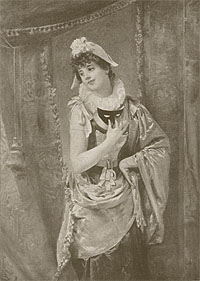
|
Adolphe Weisz, the painter of "It is I!" is a Hungarian by birth, from Buda, but studied art in
Paris under Jalabert. He carried away a medal at the Salon of 1875 and has since repeated his successes.
The scene of his picture is a private box of the Paris Opera House on the night of a masked ball.
His heroine has been flirting away the evening with a gallant of her acquaintance who has not recognized her under her mask.
The hour for unmasking has arrived, and she shows her face to him in coquettish mockery at the manner
in which she has tricked him.
|

|
"The Cascade" gives another specimen from the brush of Emile Munier, who represents the sprite of the falling
waters bathed in the spray of the stream of which she is the deity.
|
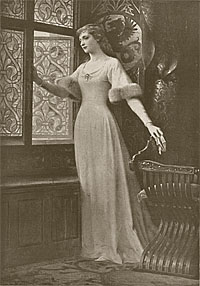
|
Among the studies which Jacques Wagrez has made of the
picturesque life of the Middle Ages and the Renaissance, none has been more fruitful
than that which he has devoted to the story of Romeo and Juliet. He is an ardent reader of
Shakespeare and spent a long time in Italy gathering material for
illustration of the play which, of all others, fascinated him most. His "Juliet" is only
one of a number of the finished results.
|

|
Writers who deal with the subject of lace invariably allude to its cobweb
structure, but it may be questioned whether the majority of them are aware of the
actual relation between the weaver of the web and the weaver of the lace, as it was
established in mythological times. According to the classic legend, Arachne was a beautiful
young maiden of Lydia, who particularly excelled in the art of lacemaking. The creations of
her skill were so lovely that they ensnared the hearts of all her sex, for even in the Golden Age,
when beauty unadorned waas supposed to be adorned the most, the congenital love of women for objects
of person adornment made itself felt. By an accident the goddess Minerva happened to destroy one of
her laces which Arachne esteemed to be her masterpiece, and the poor artist, rendered frantic by despair,
committed suicide by hanging herself. Minerva, in atonement for the wrong she had done her, converted
her into a spider, and to this day Arachne weaves her mystic web as she did in the past, and as far as their
love of lace goes, all women worship her now as they did of old. in Le Quesne's picture, the nymphs of
his artistic Aracdia are enjoying their entanglement in the silken toils of their transformed sister,
and those who are not already entangled hurry eagerly forward to seek the same filmy bondage.
|
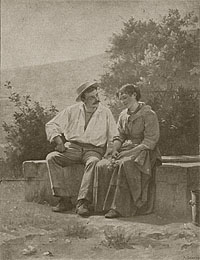
|
Alfred Henri Bramtot was born in Paris, and is a pupil of W.A. Bouguereau.
That he was a diligent and progessive pupil is evidence by the fact that he took the Prix de Rome
for painting in 1879, and that he has since become one of the notable painters of the figure of whom France
has just cause to boast. History and religious motives occupy his chief attention, but he has painted
many beautiful genre pictures of scenes of country life around his summer villa. "Bashful Love"
won him his first Salon medal, in 1879, the same year that he gained the Roman
prize. The scene is laid at one of those public wells common in France. The servant from a neighboring
country-house has come to get water from the spring, and her sweetheart, who has been working in the garden,
takes advantage of the opportunity to press his suit, while she listens modestly to his arguments.
|

|
Terentia was the wanton and dissolute first wife of the great Roman orator Cicero, whom he afterward
repudiated for her misconduct and who became a notorious public courtesan. The artist, Louis Hierle,
was born at l'Estrechure in the Department of Gard, and was a pupil of Cabanel.
|
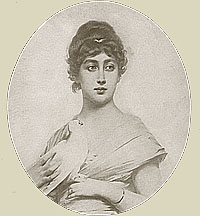
|
"A Messenger of Love" is
one of the most lovely of Nathaniel Sichel's productions.
|
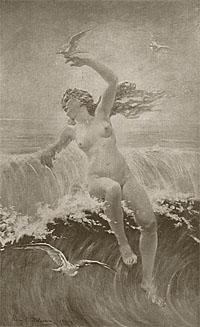
|
"Sea-Gulls and Billows" is by Henri Eugene Delacroix, a native of Solesmes in the Nord and a pupil of Cabanel.
|
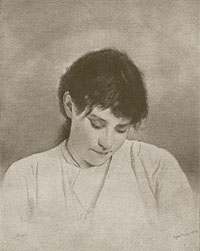
|
Gabriel Max is one of the most eminent artists modern Germany has produced. He was born in 1840 in Prague,
Bohemia, and was the son of a sculptor of great ability, Joseph Max. Until the father died, when he
was fifteen years of age, the boy worked for him in his studio and so gained his rudimentary lessons in
art in a practical way. After a three years' course at the Academy of Prague, he entered that of Vienna,
where he also remained three years. He was passionately fond of music, and this led him to make a series
of designs suggested by the works of
Beethoven, Mendelssohn, and others, which brought him great praise and substantial patronage,
and procured him the means to go to Munich, where he became a pupil of Piloty, in 1863.
He remained with Piloty until 1867, when he established a studio for himself in Munich, where he now
resides and works.
|
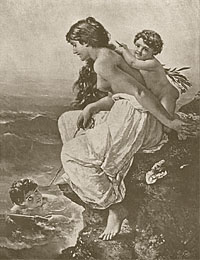
|
One of the well-known pictures of William Kray, suggested by his long
residence in Venice, is "The Venetian Swimming School."
|
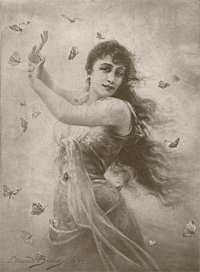
|
"The Return of Spring" is painted by
Edouard Bisson.
Another picture of the decorative feeling of line,
composition, and color is J.F. Ballavoine's "Indiscreet Butterflies."
|

|
A page of reproductions from original Pastels, by J. Ross Bryson.
|
|
|
|




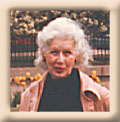
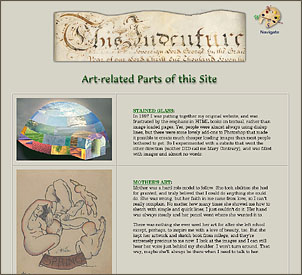



![]() Copyright © 2007, Mary S. Van Deusen
Copyright © 2007, Mary S. Van Deusen